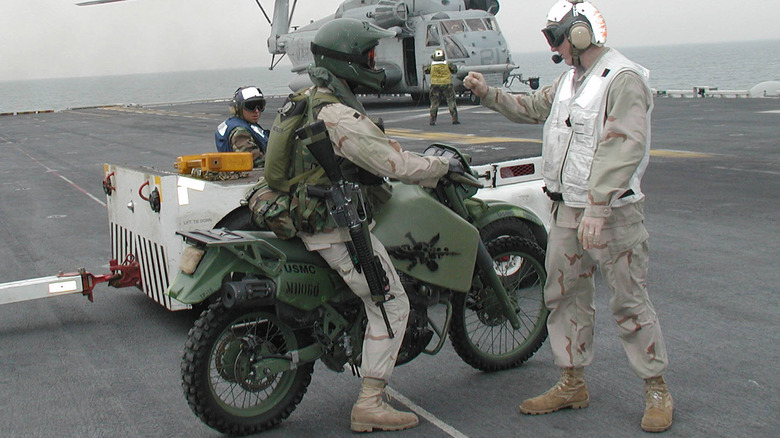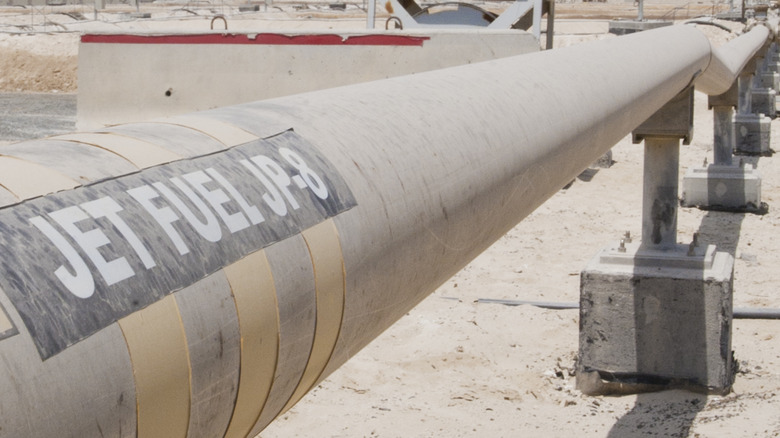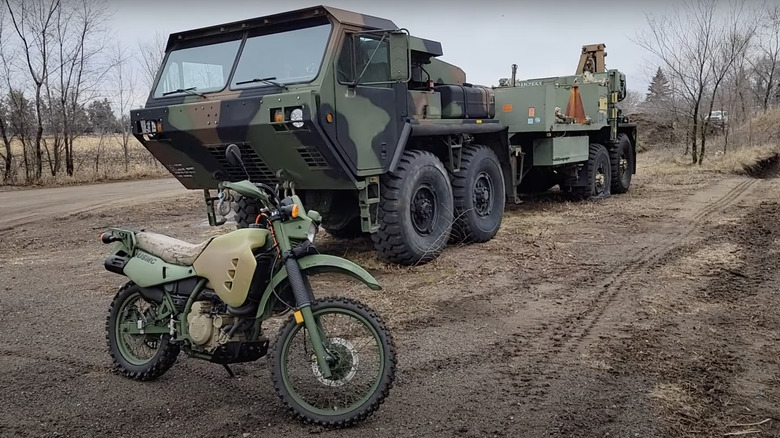The U.S Marine Corps Uses This Special Kawasaki Motorcycle That Runs On Jet Fuel
Besides old and reliable horseback riding — made famous by the 5th Special Forces Group men during the war in Afghanistan's opening stage — speeding across open terrains on an all-terrain motorcycle has been one of the other ways that the U.S military conducts light reconnaissance. While military motorcycles are primarily reserved for special operations forces, the U.S. Marine Corps once fielded over 400 modified Kawasaki KLR 650s (designated the M1030-M1) for scouting, courier, and policing duties.
What makes these motorcycles so "special"? Apart from the Kawasaki bike frame and transmission, the entire vehicle, including the engine, has been stripped out and reworked. Instead of the standard 652cc gasoline engine, the M1030-M1 is fitted with a 584cc diesel engine (a few have increased displacement up to 611cc) from Hayes Diversified Technologies (HDT). Although not powerful, with an output of around 30 horsepower, the diesel engine's high torque at low RPM (about 33 foot-pounds at 4,200 RPM) makes the M1030-M1 far more capable of traversing rough, inclined terrain than its progenitor. Moreover, the engine can propel the bike up to 90 miles per hour, making the low horsepower less of a liability.
Here's the interesting part: Despite being equipped with a diesel engine, the M1030-M1 doesn't often run on standard diesel fuel. Instead, it runs on JP-8 kerosene-based jet fuel. As strange as it sounds, the Pentagon had good reasons to invest in this re-engineering program.
[Featured image by the U.S Navy via Wikimedia Commons | Cropped and scaled | Public domain]
NATO has a single standard fuel
Since the founding of NATO in 1949, many design decisions in the U.S. military (as well as most other member countries) have been influenced by the NATO Standardization Agreement (STANAG). STANAG provides a framework for all NATO countries to design and procure equipment to ensure that, when necessary, they can share a single logistics system and use each other's gear without conflict or needing extra training.
The scope of STANAG is extremely broad, laying the groundwork for everything from the caliber of ammunition used, to the design of the plug and socket for jump-starting vehicles. Most relevant to the M1030-M1 motorcycle, STANAG also covers the type of fuel used by all militaries within the alliance. STANAG 3149 codified a Single Fuel Policy (SFP), where F-34 (the NATO codename for JP-8 jet fuel) was adopted as the universal fuel for all "land-based military aircraft, vehicles, and equipment" within the alliance.
This is why every fuel-powered piece of equipment in the U.S. military today is designed to run on jet fuel; from the legendary HMMWV (Humvee), to the M1 Abrams tank. Any vehicle sold to the U.S. military must be outfitted with an engine capable of running on jet fuel, which is how the M1030-M1's peculiar engine design came about.
The M1030-M1 was a Kawaski only in look
While motorcycle enthusiasts will immediately recognize the shape of the Kawasaki KLR 650 beneath the militarized livery, that's the only thing the M1030-M1 shares with the stock bike. Besides a new engine with every inner component like the pistons, bore, and stroke replaced to work better with a higher 20:1 compression ratio, the bike was also extensively ruggedized to meet the military's requirements.
The handlebar is integrated with a hand and control guard. A heavy-duty equipment rack comes pre-equipped on the back of the bike, allowing the operator to ferry about 50 pounds of weapons and supplies. When needed, two hard cases can also be mounted on either side of the bike to increase storage capacity. And, just like any tactical vehicle, the bike's driving and tail lights have a blackout mode to improve stealth in missions that require maximum discretion. An IR driving light for use alongside night vision goggles can also be equipped.
HDT produced for the Marines around 440 of these bikes up to the late 2000s when they were phased out. Being STANAG-compliant, reports suggest that many NATO countries have also placed orders for the M1030-M1, although specific details on which countries and the quantities are vague. These motorcycles are no longer in service today, and the entire fleet was auctioned off on the civilian market a while ago. If you're lucky, you may be able to find a running sample today.


